山手線の新宿からひとつ目、新大久保で食事しようと思うと、韓国、タイ、中国、インド、中近東の食べ物のことばかりで、伝統的な日本蕎麦を思い浮かべることはまずありません。
でも、新大久保は、多国籍文化のるつぼとなるよりずっと以前は、歴史的に重要な役割を担った場所です。
百人町は、4世紀も前に徳川将軍によって東京の新しく確立した中心地を保護するよう命じられた100人のサムライによる分隊を指す語です。
When I think about eating in Shin-Okubo, the station next to Shinjuku on the Yamanote Line, Korean, Thai, Chinese, Indian and Middle Eastern food comes to mind, but certainly not traditional Japanese soba noodles.
Long before Shin-Okubo was the cultural melting pot of Tokyo, it played an important role in the history of Tokyo. Hyakunincho is a word that refers to the 100-men squad of samurai assigned by the Tokugawa shogun to protect the newly established capital of Tokyo four centuries ago.
「百人町 近江家」は、JR新大久保駅の目の前にあるので、かえって見過ごしやすかった!
私は何度もお腹を空かせてエスニック料理のある方へ向かって歩いていたんです。
ここを通ったことがあったのに、今まで気づかなかったは残念でした。
Hyakunincho Omiya soba shop, located a few meters across from the JR Shin-Okubo Station, is easy to miss.
I myself have passed by here many times with an empty stomach on my way to something a little more exotic, but now that I’ve been here once, I regret not stopping by before.
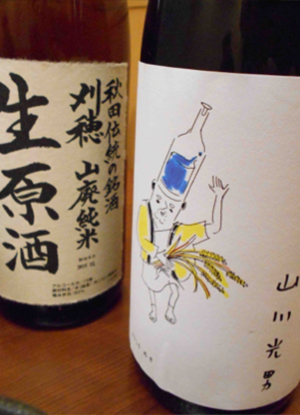
[Photo:two kinds of sake]
【写真:2種類の酒】
のれんをくぐると、お店の方と日本的な雰囲気に迎えられます。
四代目の店主、永谷さんからまず日本酒とおつまみをすすめられました。
美味しい蕎麦を楽しむために蕎麦の前にお酒をいただくのが「正統」なのだと聞いた気がするけど、それって本当? 近江家さんは、日本各地からいろんな種類の日本酒を取り揃えています。
Push back the noren curtain at the entrance and the staff and the traditional Japanese atmosphere welcomes you.
Nagatani-san, the chef and fourth-generation owner, recommends sake and a few appetizers before the soba.
Having sake before the soba is the “right” way to enjoy a meal of fine soba, or so I’m told. But which one?
Omiya’s sake list is long with a variety from Japan’s countryside.
「山川光男」は、山形の4つの酒蔵がコラボした酒。
白米を挽いて作られたそうな。ユニークなラベルが独特の風味とマッチしています!
その次にいただいた秋田のお酒「刈穂」は、+21 という超辛口の純米酒。辛いのに味わい深くてなめらかです。
Yamakawa Mitsuo sake, a collaborative effort between four sake brewers in Yamagata, is made with milled white rice.
The unique writing on the label matches the unique flavor! And then from Akita, Kariho sake is a superdry 21-proof sake made with polished rice, resulting in a full-bodied smooth flavor.
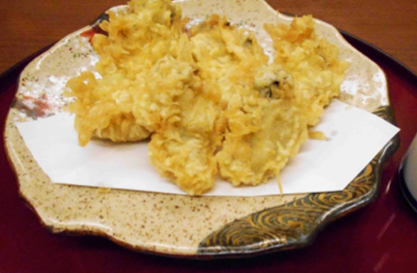
[Photo:tempura oysters]
【写真:牡蠣の天ぷら】
さて、「そばみそ」という小鉢が出てきました。
赤味噌とゴマ油を練った甘い味噌に、炒った蕎麦の実が混ざっていて香ばしい。
日本に長く住んでいる私が今までなぜ知らなかったのかと思うほどのごちそうです。
And now it’s time for appetizers served with something in a tiny bowl called sobamiso. A fragrant mix of fried soba grains with dipping sauce, red and also sweet miso paste combined with sesame oil.
Although I’m a long-timer in Japan, this is a treat I’ve somehow missed.
全部食べたいけど...まずは牡蠣の天ぷら。牡蠣フライはよくあるけどこれは珍しい!
外はカラッとしているのに中は新鮮なのは特別なスキルが必要なんです。近江家さんは完璧な技があるんですね。
I want to try everything, so... first, tempura oystersーyou don’t see that every day.
Fried oysters are common, but getting a crispy tempura crust and a fresh flavor with oysters requires extra skill, something Omiya has perfected.
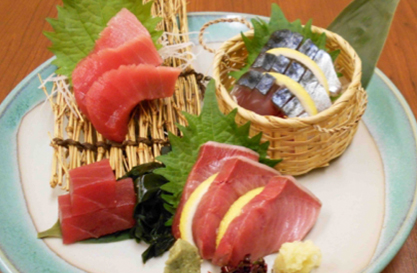
[Photo: sashimi assortment]
【写真:刺身盛り合わせ】
お刺身の盛り合わせは豪華です。
まぐろや青魚もおいしいけど、その日のおすすめのブリは、脂が乗ってとってもおいしい!
ツマの芽紫蘇、レモン、生姜など、いろんな風味も舌をうならせます!
The sashimi assortment makes a great picture.
And then the flavors: tuna and blue-backed fish are always great, but the fish of the day, amberjack, is especially tender and delicious!
For accentーshiso leaf and buds, lemon, ginger...so many flavors to please the tongue!
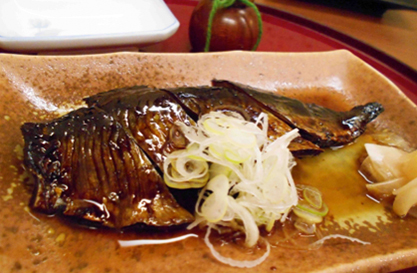
[Photo:kyo-nishin]
【写真:京にしん】
次に来たのは「京にしん」。
パックされた味付にしんは食べたことがありますが、自家製の甘ダレ味のにしんは口の中でとろけます。
これだけでも絶品ですけど、ご飯の上に乗せて食べたくなりました。
Next comes kyo-nishin.
I’ve had seasoned herring from a package before, but the sweet-sauce herring prepared at Omiya melts in your mouth.
This alone would make a great main course, but there’s more to come.
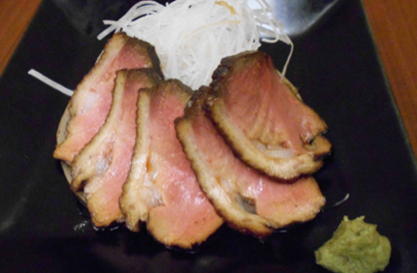
[Photo:kamo-wasa]
【写真:鴨わさ】
「鴨わさ」は、ローストした鴨のスライスに蕎麦つゆをかけ、おろしワサビで食べるんです。
柔らかくて上品な味!美味しすぎて、いくらでも食べられそう。
Kamo-wasa is sliced roast duck drizzled with soba noodle dipping sauce, and served with grated wasabiーso tender, so refined.
I have to remember to take little bites to make it last.
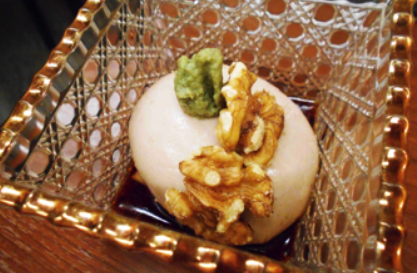
[Photo:walnut tofu]
【写真:くるみ豆腐】
私は和食に関してはほとんど知っている、と思っていたのは気のせいでした。
「くるみ豆腐」は初めてです。まろやかでプリンみたいだけど、もっと奥深くて絶妙! これ目当てにくる人もいるとのこと。納得です!
When it comes to Japanese food, I’ve had it all, or so I thought.
But walnut tofu? Smooth, fragrant, flavors like pudding, but much deeper and more subtle! “Some people come just for this,” I’m told, and I’m not surprised.
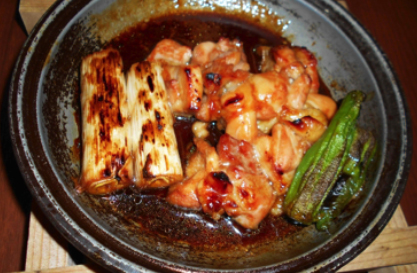
[Photo:yakitori]
【写真:焼鳥】
焼鳥は、たいてい串刺しで出てくるものですが、近江家さんでは葱と獅子唐芥子と一緒にいただきます。
食欲をそそるタレは、全て手作りだという店主の誇りが伝わります。
Yakitori served on big toothpick skewers is what you usually get, but Omiya serves it deliciously with onion and shishito peppers.
The mouthwatering sauce is proof that the chef takes pride in making everything by hand.
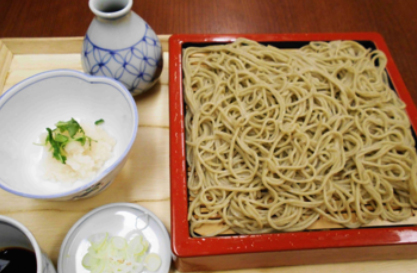
[Photo:spicy daikon-radish soba]
【写真:辛味大根蕎麦】
たくさんの料理を味わいましたが、あとひとつ。
そう、お蕎麦です!「辛味大根蕎麦」をいただきました。蕎麦にワサビはつきものですが、辛味大根は珍しい。
確かにピリッときます。いろんな味でまったりした舌が目覚めるようです。細く上品で香り豊かな麺には、際立つ味と練り込みからできるコシがあります。
Although a dozen or more dishes have already passed in front of me, there’s just one moreーthe soba! Spicy daikon-radish soba for me.
Most soba with wasabi paste is everyday, but spicy daikon is unique, andーyesーit is spicy.
It kind of wakes up your tongue put to sleep by all the flavors that have come before. The slender, elegant, fragrant buckwheat noodles have achieved the distinct flavor and texture of handmade noodles.
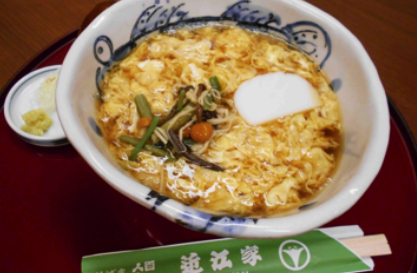
[Photo: kakitama udon]
【写真:かき玉うどん】
お腹にまだ余裕があれば、太麺のうどんも食べてみてほしいです。
葛粉でとろみを出した「かき玉うどん」は、コクのある風味がたまりません。
And now if you still have room, try the thick udon noodles.
Egg drop soup thickened with kuzu flour is a bowl of indescribably rich flavors.
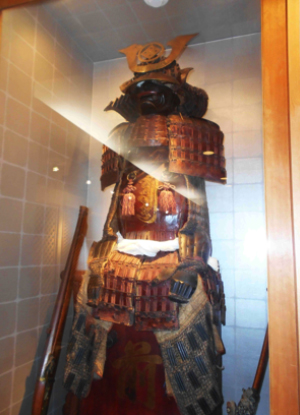
[Photo: suit of armor]
【写真:甲冑】
浅草で修行した初代が、青山に店を出したのは4代前。
その時から、最高の蕎麦を提供するという近江家さんの使命が始まったと言えます。
1900年代初めに、新大久保駅近くの百人町に移転して以来、この文化的に絶えず変貌する激選区にあって、近江家さんは伝統的な和食の店を守り続けています。
そしてもうひとつは、たかが蕎麦屋だとおっしゃる近江家さんの控え目さ。本物の和食を体験したければ、ここはぜひ行ってほしい場所です。
それから、お店を出る前にはガラスケースの中の甲冑をちょっと見てください。これは、町名となりこの店につく「百人町」の由来となった侍が身につけた甲冑の現物です。
The Omiya mission to provide the best possible soba experience started four generations ago when the first owner, having trained in Asakusa, set up his own shop in Aoyama.
Since moving to Hyakukunincho near the Shin-Okubo Station exit in the early 1900s, the shop has represented fine traditional Japanese dining in this ever-changing culturally cluttered part of Tokyo.
And one more thingーsaying that Omiya is just a soba shop is such an understatement. For an authentic Japanese eating experience, this is the place to go.
And, before you leave, take a moment to look at the samurai suit of armor in the glass case.
This is an original suit of armor worn by one the samurai that became the namesake for this area, and for Hyakunincho Omiya.
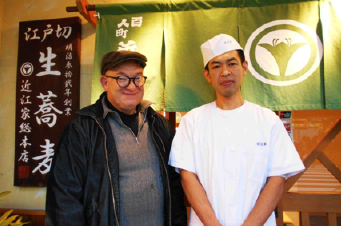
[Photo: A commemorative photo with the owner, Nagatani-san]
【写真:ご主人の永谷さんと記念撮影】
![]()

■David Thayne(デイビッド・セイン) プロフィール
1959年、米国生まれ。
証券会社勤務を経て来日し、翻訳・通訳など多岐にわたって活躍。
豊富な教授経験を生かし、数多くの英語関係書籍を執筆。
近著に『日本人のチョットへんな英語』(アスコム)、『超入門シャドーイング』(主婦の友社)、日本人が使いすぎる英語(PHP文庫)など多数。
下町の魅力に魅了され、自身が代表を務める英語関連のコンテンツ会社のエートゥーゼットのオフィスを根津に構えている。
英会話本の執筆をしながら、東京・文京区根津と春日にあるエートゥーゼット英語学校の校長も務める。
http://www.smartenglish.co.jp/
